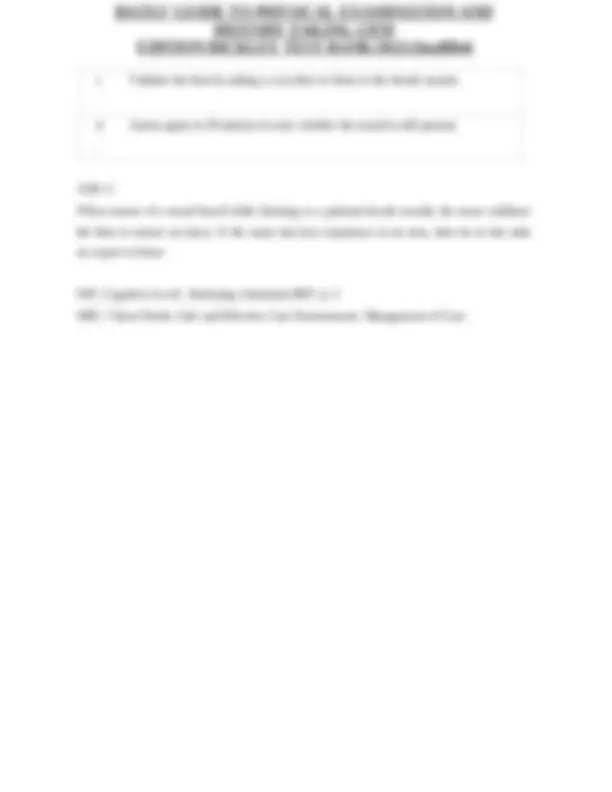






























































































Study with the several resources on Docsity

Earn points by helping other students or get them with a premium plan


Prepare for your exams
Study with the several resources on Docsity

Earn points to download
Earn points by helping other students or get them with a premium plan
Community
Ask the community for help and clear up your study doubts
Discover the best universities in your country according to Docsity users
Free resources
Download our free guides on studying techniques, anxiety management strategies, and thesis advice from Docsity tutors
A test bank for the 13th edition of Bates’ Guide To Physical Examination and History Taking. It includes questions and answers related to the foundations of clinical proficiency, assessment data, nursing process, evidence-based practice, and priority setting. The questions cover topics such as objective and subjective data, novice and expert nurses, nursing interventions, and holistic health. useful for students studying nursing, medicine, or healthcare-related fields.
Typology: Exams
1 / 450

This page cannot be seen from the preview
Don't miss anything!





























































































Bates’ Guide To Physical Examination and History Taking 13th Edition Bickley Test Bank CHAPTER 1 Foundations for Clinical Proficiency
b . Reflective. c . Subjective. d . Introspective. ANS: C Subjective data are what the person says about him or herself during history taking. Objective data are what the health professional observes by inspecting, percussing, palpating, and auscultating during the physical examination. The terms reflective and introspective are not used
c . Validate the data by asking a coworker to listen to the breath sounds. d . Assess again in 20 minutes to note whether the sound is still present. ANS: C When unsure of a sound heard while listening to a patients breath sounds, the nurse validates the data to ensure accuracy. If the nurse has less experience in an area, then he or she asks an expert to listen. DIF: Cognitive Level: Analyzing (Analysis) REF: p. 2 MSC: Client Needs: Safe and Effective Care Environment: Management of Care
a . EBP relies on tradition for support of best practices. b . EBP is simply the use of best practice techniques for the treatment of patients. c . EBP emphasizes the use of best evidence with the clinicians experience. d . The patients own preferences are not important with EBP. ANS: C EBP is a systematic approach to practice that emphasizes the use of best evidence in combination with the clinicians experience, as well as patient preferences and values, when making decisions about care and treatment. EBP is more than simply using the best practice techniques to treat patients, and questioning tradition is important when no compelling and supportive research evidence exists. DIF: Cognitive Level: Applying (Application) REF: p. 5 MSC: Client Needs: Safe and Effective Care Environment: Management of Care
First-level priority problems are those that are emergent, life threatening, and immediate (e.g., establishing an airway, supporting breathing, maintaining circulation, monitoring abnormal vital signs) (see Table 1-1). DIF: Cognitive Level: Understanding (Comprehension) REF: p. 4 MSC: Client Needs: Safe and Effective Care Environment: Management of Care
DIF: Cognitive Level: Understanding (Comprehension) REF: p. 2 MSC: Client Needs: Safe and Effective Care Environment: Management of Care
c Admission . d Collaborative . ANS: A An accurate nursing diagnosis provides the basis for the selection of nursing interventions to achieve outcomes for which the nurse is accountable. The other items do not contribute to the development of appropriate nursing interventions. DIF: Cognitive Level: Understanding (Comprehension) REF: p. 6 MSC: Client Needs: Safe and Effective Care Environment: Management of Care
d Sleep, pain, and breathing . ANS: A First-level priority problems are immediate priorities, remembering the ABCs (airway, breathing, and circulation), followed by second-level problems, and then third-level problems. DIF: Cognitive Level: Analyzing (Analysis) REF: p. 4 MSC: Client Needs: Safe and Effective Care Environment: Management of Care
b . Lack of significant research studies. c . Insufficient clinical skills of nurses. d . Inadequate physical assessment skills. ANS: A As individuals, nurses lack research skills in evaluating the quality of research studies, are isolated from other colleagues who are knowledgeable in research, and often lack the time to visit the library to read research. The other responses are not considered barriers.
d . Teach the nurses how to conduct electronic searches for research studies. ANS: D Facilitating support for EBP would include teaching the nurses how to conduct electronic searches; time to visit the library may not be available for many nurses. Actually conducting research studies may be helpful in the long-run but not an immediate solution to reviewing existing research. DIF: Cognitive Level: Applying (Application) REF: p. 6
MSC: Client Needs: Safe and Effective Care Environment: Management of Care
a . Patients history of allergies. b . Patients use of medications at home. c . Last menstrual period 1 month ago. d . 2 5 cm scar on the right lower forearm. ANS: D Objective data are the patients record, laboratory studies, and condition that the health professional observes by inspecting, percussing, palpating, and auscultating during the physical examination. The other responses reflect subjective data. DIF: Cognitive Level: Applying (Application) REF: p. 2 MSC: Client Needs: Safe and Effective Care Environment: Management of Care
The complete data base is collected in a primary care setting, such as a pediatric or family practice clinic, independent or group private practice, college health service, womens health care agency, visiting nurse agency, or community health agency. In these settings, the nurse is the first health professional to see the patient and has the primary responsibility for monitoring the persons health care. DIF: Cognitive Level: Applying (Application) REF: p. 6 MSC: Client Needs: Safe and Effective Care Environment: Management of Care